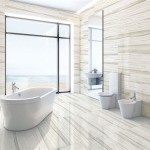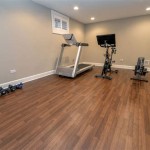Floating Floor Tiles for Bathrooms
Bathroom renovations often involve flooring upgrades, and floating floor tiles offer a compelling option for homeowners seeking a balance of aesthetics, durability, and ease of installation. Unlike traditional tile installations that require mortar and grout, floating floor tiles click together, forming a "floating" surface above the subfloor. This article explores the advantages and disadvantages of floating floor tiles for bathrooms, the various material options available, and key considerations for installation and maintenance.
Advantages of Floating Floor Tiles in Bathrooms
One of the primary advantages of floating floor tiles is their simplified installation process. The click-lock mechanism eliminates the need for messy adhesives and specialized tools, making it a suitable project for DIY enthusiasts. This ease of installation also translates to faster project completion and potentially lower labor costs. Furthermore, floating floor tiles offer a certain degree of flexibility, allowing for minor subfloor imperfections to be accommodated without extensive preparation.
Another significant benefit is the inherent water resistance of many floating floor tile options. While not entirely waterproof, materials like vinyl and engineered wood with waterproof cores offer excellent protection against splashes and spills, making them suitable for the humid bathroom environment. The interlocking design also helps prevent water from seeping between the tiles and reaching the subfloor.
Finally, floating floor tiles provide design versatility, coming in a wide range of styles, colors, and textures. Homeowners can choose from realistic wood looks, sleek stone finishes, or vibrant patterned designs to complement their existing bathroom décor. The variety of options allows for creating a customized look that fits any aesthetic preference.
Material Options for Floating Floor Tiles
Several materials are commonly used in the construction of floating floor tiles, each with its own set of characteristics and suitability for bathroom applications. Vinyl is a popular choice due to its affordability, water resistance, and durability. Luxury vinyl tiles (LVT) and vinyl plank flooring (LVP) offer realistic wood and stone visuals, providing aesthetic appeal alongside practicality.
Engineered wood is another viable option, offering the natural beauty of wood with enhanced stability and moisture resistance. Engineered wood tiles consist of a core layer of plywood or high-density fiberboard (HDF) topped with a thin veneer of real wood. Look for engineered wood specifically designed for bathrooms, often incorporating waterproof core technology.
While less common, laminate flooring can also be used in bathrooms with careful consideration. Laminate tiles are constructed with a fiberboard core and a decorative layer, topped with a wear-resistant coating. Moisture-resistant laminate options are available, but proper installation and maintenance are crucial to prevent water damage.
Ceramic and porcelain tiles are also available in a floating format. These offer the classic look and durability of traditional tile with the added benefit of easier installation. They often utilize a click-lock system with an integrated underlayment for comfort and sound absorption.
Installation and Maintenance Considerations
Proper installation is essential for the long-term performance of floating floor tiles. The subfloor must be clean, level, and dry before installation begins. An underlayment is often recommended to provide cushioning, sound insulation, and a moisture barrier. Following the manufacturer’s instructions carefully ensures a secure and stable installation.
Maintaining floating floor tiles in bathrooms involves regular cleaning to prevent the buildup of dirt, grime, and soap residue. Sweeping or vacuuming with a soft brush attachment is recommended. Avoid using abrasive cleaners or excessive water, as these can damage the surface of the tiles. Promptly address spills to prevent water from seeping into the seams.
While floating floor tiles offer a degree of water resistance, they are not completely waterproof. Standing water should be avoided, and any leaks or plumbing issues should be addressed immediately to prevent damage to the subfloor and tiles. Proper ventilation in the bathroom also helps to minimize moisture buildup, further protecting the flooring.
Choosing the right type of floating floor tile for a bathroom requires careful consideration of the specific needs and conditions of the space. Factors such as budget, aesthetic preferences, and the level of moisture exposure should all influence the decision-making process.

Bathroom Flooring Ideas The Home

How To Install Waterproof Laminate Flooring Twenty Oak

Milan Marble 12 In W X 24 L Waterproof Floating Vinyl Tile Flooring 18 Sq Ft Box

Bathroom Flooring Ideas The Home

How To Install A Floating Tile Floor

How To Install Vinyl Plank Flooring In A Bathroom Fixthisbuildthat

What Is The Best Tile For Bathroom Floors Angi

Bathroom Flooring Ideas The Home

How To Install Vinyl Plank Tiles In A Bathroom

What Is The Best Flooring For Bathrooms Tarkett








